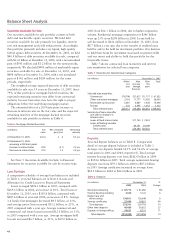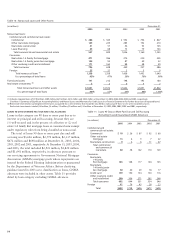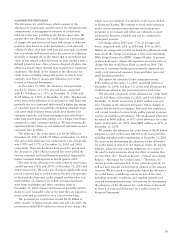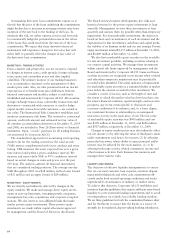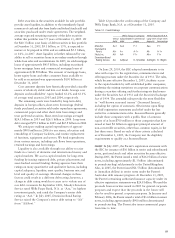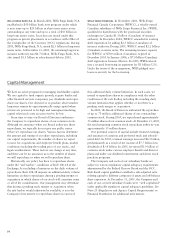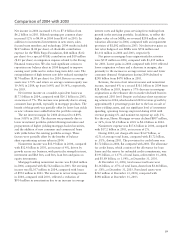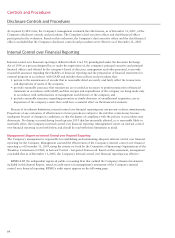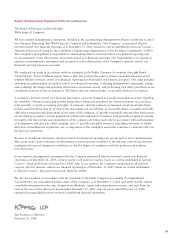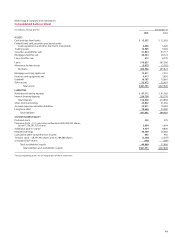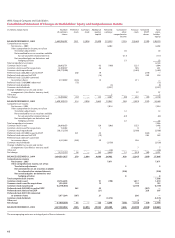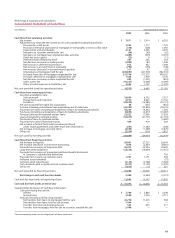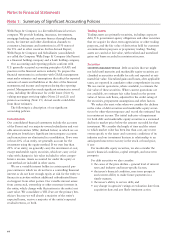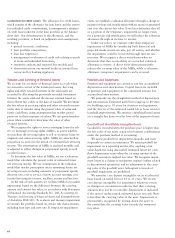Wells Fargo 2005 Annual Report Download - page 58
Download and view the complete annual report
Please find page 58 of the 2005 Wells Fargo annual report below. You can navigate through the pages in the report by either clicking on the pages listed below, or by using the keyword search tool below to find specific information within the annual report.
56
Capital Management
We have an active program for managing stockholder capital.
We use capital to fund organic growth, acquire banks and
other financial services companies, pay dividends and repur-
chase our shares. Our objective is to produce above-market
long-term returns by opportunistically using capital when
returns are perceived to be high and issuing/accumulating
capital when such costs are perceived to be low.
From time to time our Board of Directors authorizes
the Company to repurchase shares of our common stock.
Although we announce when our Board authorizes share
repurchases, we typically do not give any public notice
before we repurchase our shares. Various factors determine
the amount and timing of our share repurchases, including
our capital requirements, the number of shares we expect
to issue for acquisitions and employee benefit plans, market
conditions (including the trading price of our stock), and
legal considerations. These factors can change at any time,
and there can be no assurance as to the number of shares
we will repurchase or when we will repurchase them.
Historically, our policy has been to repurchase shares
under the “safe harbor” conditions of Rule 10b-18 of the
Exchange Act including a limitation on the daily volume of
repurchases. Rule 10b-18 imposes an additional daily volume
limitation on share repurchases during a pending merger or
acquisition in which shares of our stock will constitute some
or all of the consideration. Our management may determine
that during a pending stock merger or acquisition when
the safe harbor would otherwise be available, it is in the
Company’s best interest to repurchase shares in excess of
this additional daily volume limitation. In such cases, we
intend to repurchase shares in compliance with the other
conditions of the safe harbor, including the standing daily
volume limitation that applies whether or not there is a
pending stock merger or acquisition.
In 2005, the Board of Directors authorized the repurchase
of up to 75 million additional shares of our outstanding
common stock. During 2005, we repurchased approximately
53 million shares of our common stock. At December 31, 2005,
the total remaining common stock repurchase authority was
approximately 35 million shares.
Our potential sources of capital include retained earnings,
and issuances of common and preferred stock and subordi-
nated debt. In 2005, retained earnings increased $4.1 billion,
predominantly as a result of net income of $7.7 billion less
dividends of $3.4 billion. In 2005, we issued $1.9 billion of
common stock under various employee benefit and director
plans and under our dividend reinvestment and direct stock
purchase programs.
The Company and each of our subsidiary banks are
subject to various regulatory capital adequacy requirements
administered by the Federal Reserve Board and the OCC.
Risk-based capital guidelines establish a risk-adjusted ratio
relating capital to different categories of assets and off-balance
sheet exposures. At December 31, 2005, the Company and
each of our covered subsidiary banks were “well capitalized”
under applicable regulatory capital adequacy guidelines. See
Note 25 (Regulatory and Agency Capital Requirements) to
Financial Statements for additional information.
WELLS FARGO BANK, N.A. In March 2003, Wells Fargo Bank, N.A.
established a $50 billion bank note program under which
it may issue up to $20 billion in short-term senior notes
outstanding at any time and up to a total of $30 billion in
long-term senior notes. Securities are issued under this
program as private placements in accordance with Office of
the Comptroller of the Currency (OCC) regulations. During
2005, Wells Fargo Bank, N.A. issued $2.3 billion in long-term
senior notes. At December 31, 2005, the remaining long-term
issuance authority was $6.7 billion. Wells Fargo Bank, N.A.
also issued $1.5 billion in subordinated debt in 2005.
WELLS FARGO FINANCIAL. In November 2003, Wells Fargo
Financial Canada Corporation (WFFCC), a wholly-owned
Canadian subsidiary of Wells Fargo Financial, Inc. (WFFI),
qualified for distribution with the provincial securities
exchanges in Canada $1.5 billion (Canadian) of issuance
authority. In December 2004, WFFCC amended its existing
shelf registration by adding $2.5 billion (Canadian) of
issuance authority. During 2005, WFFCC issued $2.2 billion
(Canadian) in senior notes. The remaining issuance capacity
for WFFCC of $700 million (Canadian) expired in
December 2005. In January 2006, a $7.0 billion (Canadian)
shelf registration became effective. In 2005, WFFI entered
into a secured borrowing arrangement for $1 billion (U.S.).
Under the terms of the arrangement, WFFI pledged auto
loans as security for the borrowing.


